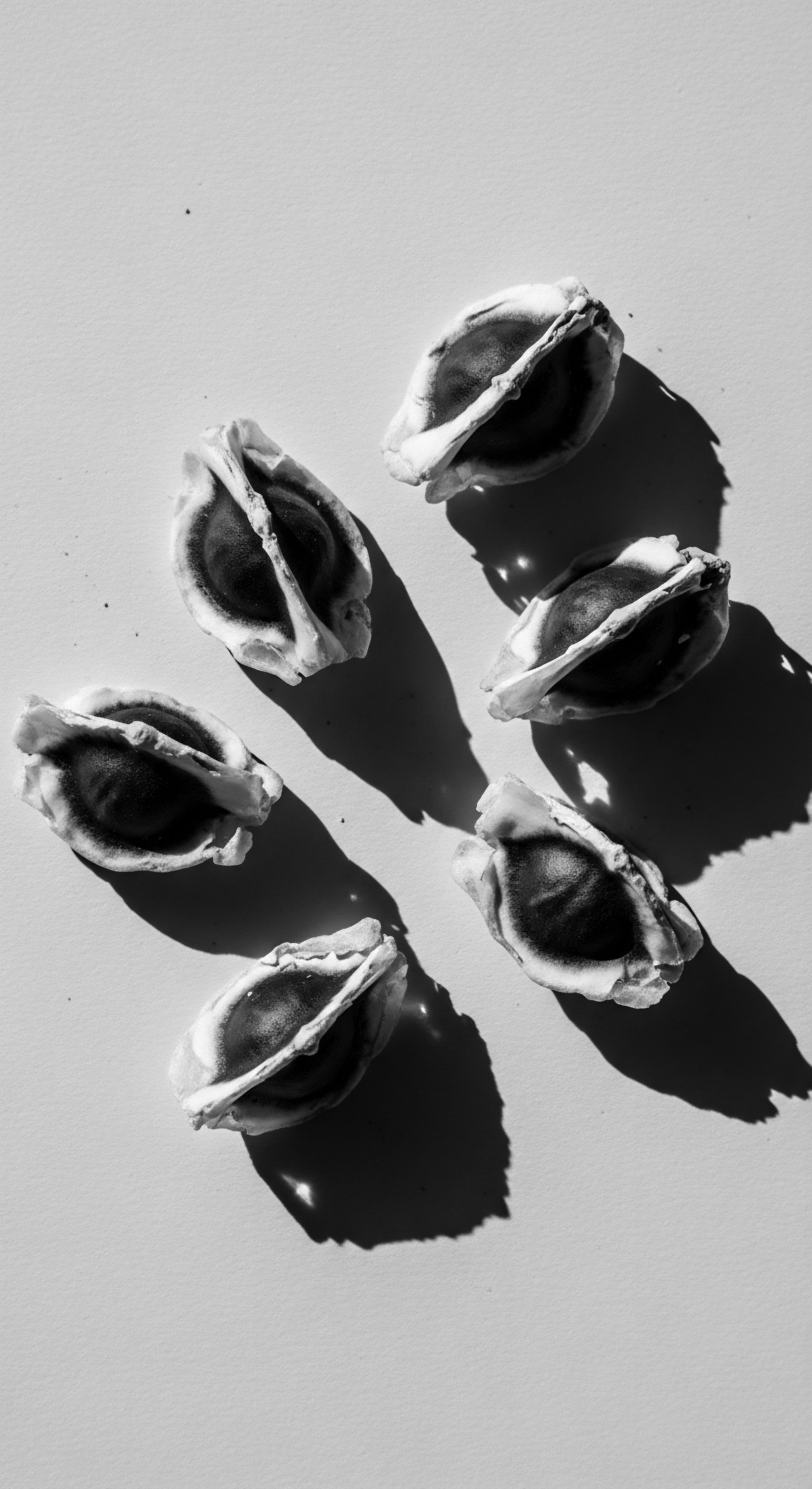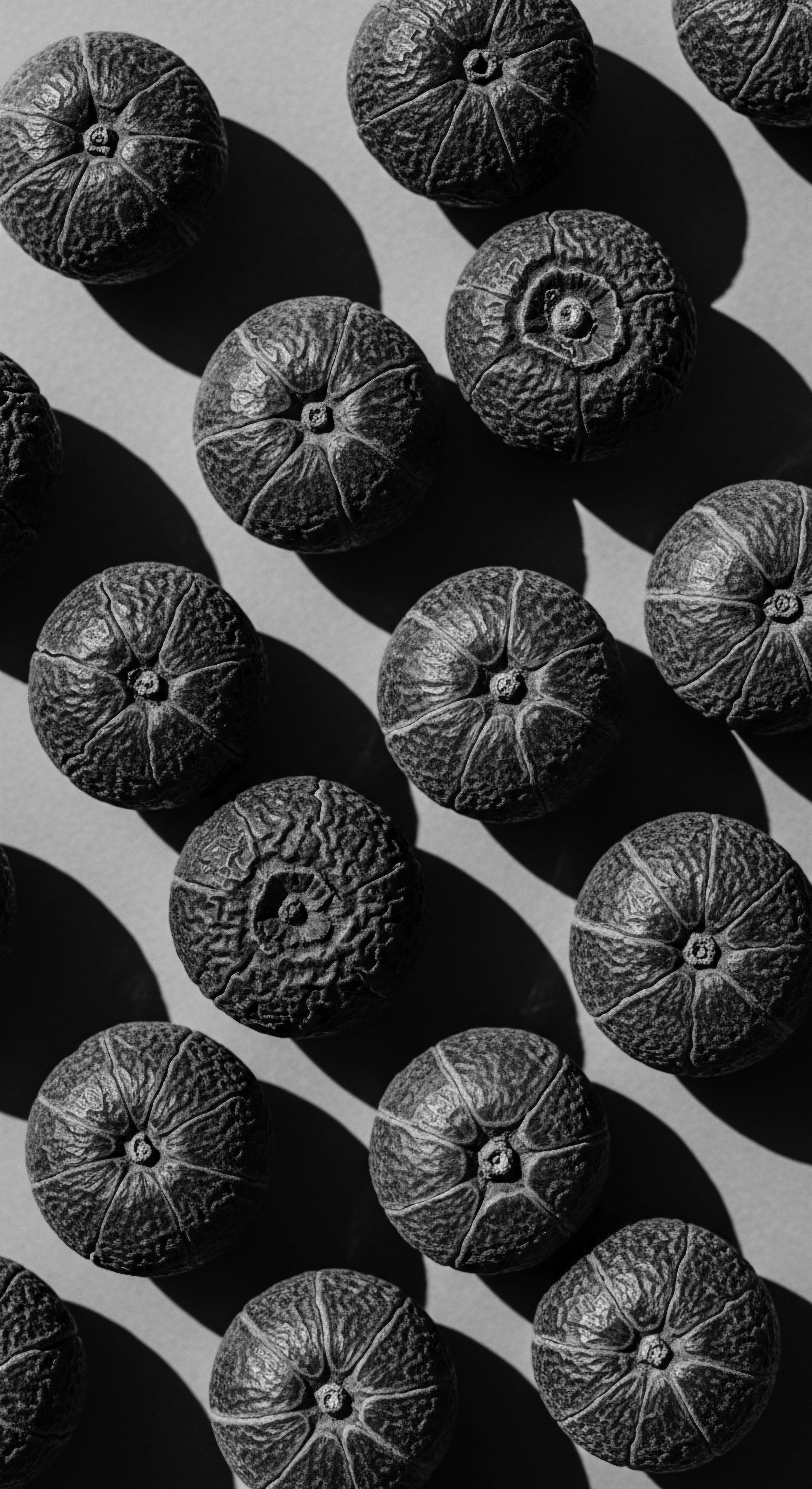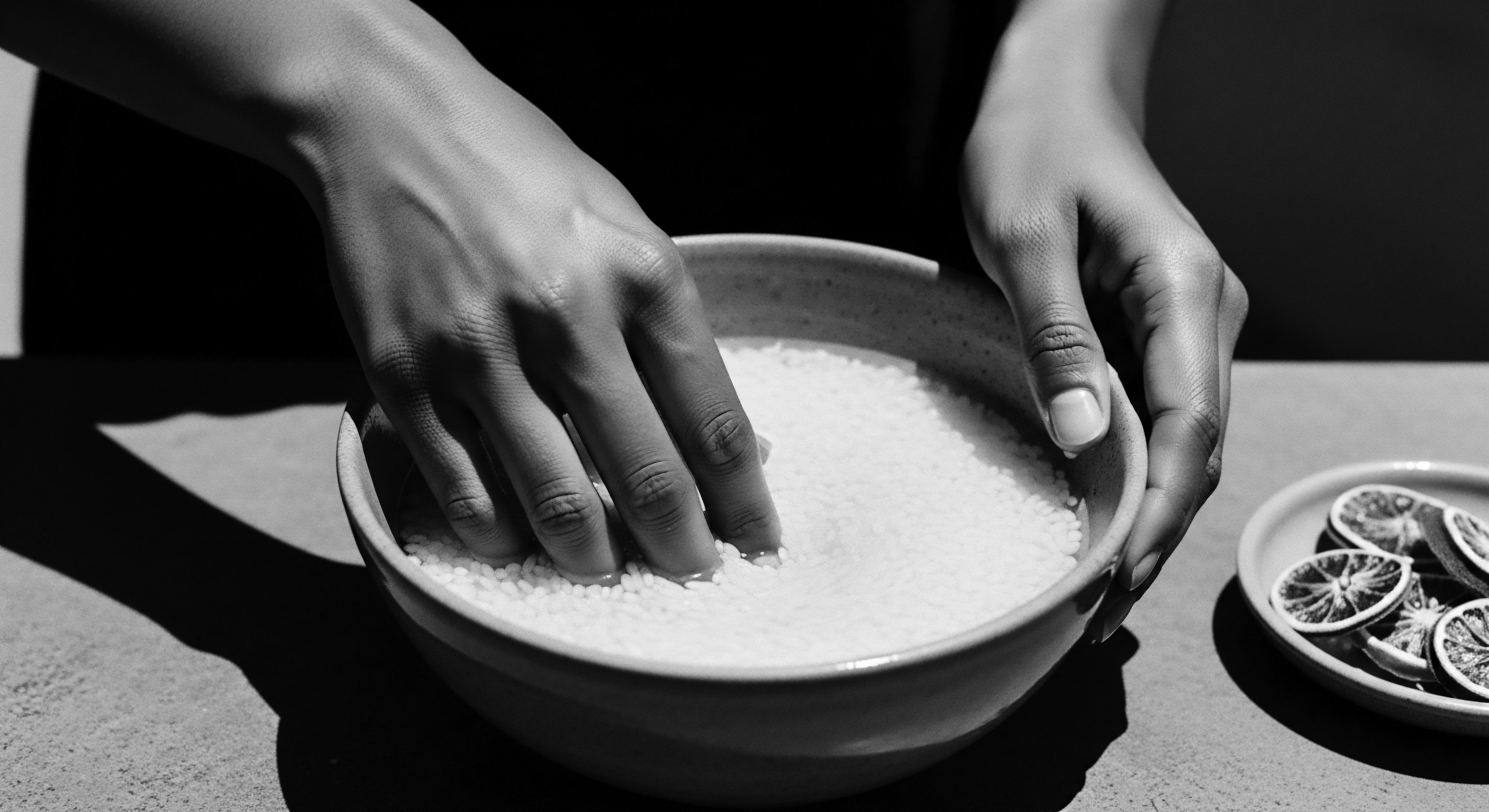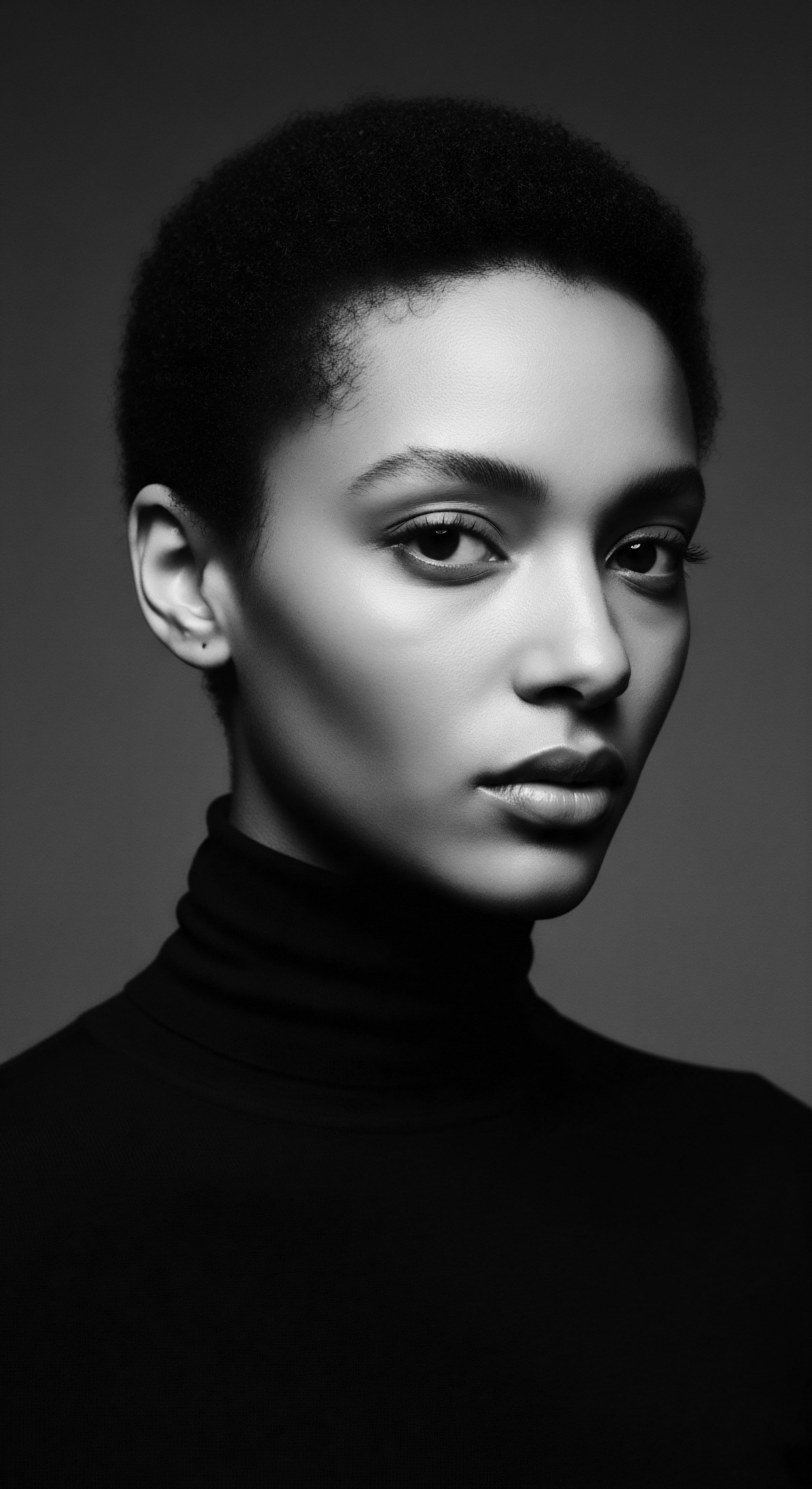
Fundamentals
Within the expansive living library of Roothea, the term ‘Reproductive Health’ holds a profound significance, extending far beyond clinical parameters. It describes the complete physical, mental, and social well-being of individuals concerning their reproductive systems and processes, rather than simply the absence of disease or infirmity. For those whose crowning glory is textured hair, this designation carries layers of ancestral memory and lived experience, linking the rhythms of the body to the very strands that adorn and express identity. The cyclical nature of life, from maidenhood through motherhood and into elder wisdom, often manifests visible changes in hair, prompting traditional care practices that have been passed down through generations.
This fundamental explanation recognizes that the reproductive journey, with its hormonal fluctuations and energetic shifts, directly influences the hair follicle. The delicate balance within the body, governed by the intricate dance of hormones, dictates the growth cycles, strength, and even the very texture of hair. From the first blush of puberty, when nascent hormonal shifts begin to shape individual physiological expressions, to the wisdom of menopause, when profound transformations redefine the body’s internal landscape, the hair responds. Traditional societies, observing these undeniable connections, developed specific rituals and remedies, recognizing hair as a barometer of internal vitality and a sacred extension of self.
Reproductive Health, in the context of textured hair heritage, describes the holistic well-being of individuals as it relates to their reproductive systems and processes, profoundly influencing the very nature of their hair and its care through life’s cycles.
The initial delineation of Reproductive Health, as understood through the lens of textured hair heritage, encompasses the understanding of basic biological processes. This includes the menstrual cycle, the journey of conception and gestation, the postpartum period, and the transition into perimenopause and menopause. Each phase brings distinct hormonal profiles that can influence hair density, elasticity, and even curl pattern.
For instance, the surge of estrogens during pregnancy often leads to a prolongation of the anagen (growth) phase of hair, resulting in thicker, more lustrous strands for many. Conversely, the precipitous drop in estrogen after childbirth can trigger a synchronized shedding, often referred to as postpartum hair effluvium, a phenomenon recognized and addressed in many ancestral hair care traditions.
Ancestral communities, lacking modern scientific instruments, relied on keen observation and generations of accumulated wisdom to interpret these bodily signals. Their understanding of hair health was inextricably linked to the overall vitality of the individual, particularly during periods of reproductive change. The methods employed were often deeply communal, involving the sharing of knowledge, the preparation of botanical remedies, and the performance of supportive rituals. These practices were not merely cosmetic; they were acts of reverence for the body’s natural rhythms and a celebration of life’s continuity.
A primary explanation of this concept acknowledges the profound impact of internal systemic balance on the external manifestation of hair. The delicate interplay between various endocrine glands, particularly the ovaries, adrenal glands, and thyroid, orchestrates a symphony of hormonal signals that directly communicate with hair follicles. When these systems operate in harmonious alignment, hair often displays its inherent strength and vibrancy. When imbalances occur, whether due to physiological stressors, nutritional deficiencies, or significant reproductive transitions, the hair can exhibit changes in texture, growth rate, or retention.
- Hormonal Fluctuations ❉ The ebb and flow of hormones, particularly estrogens, androgens, and thyroid hormones, directly regulate the hair growth cycle and follicle health.
- Nutritional Needs ❉ Reproductive stages demand specific nutritional support; deficiencies in iron, zinc, or B vitamins can compromise hair vitality.
- Stress Responses ❉ Emotional and physical stressors, often heightened during reproductive transitions, can trigger hair shedding or thinning.
- Ancestral Practices ❉ Traditional hair care rituals often aligned with these physiological shifts, offering remedies for strengthening hair during vulnerable periods.
The designation of Reproductive Health within Roothea’s archive begins with these foundational insights, setting the stage for a deeper exploration of how ancestral knowledge and modern understanding intertwine to honor the unique heritage of textured hair through every season of life. It is a statement that affirms the intrinsic connection between inner well-being and the outer expression of one’s heritage.

Intermediate
Moving beyond the foundational understanding, an intermediate exploration of Reproductive Health within Roothea’s lexicon reveals its intricate connections to the historical and cultural experiences of textured hair. This broader interpretation recognizes that the biological realities of reproductive cycles are always contextualized by social narratives, community practices, and the enduring legacy of ancestral wisdom. The very meaning of hair, particularly for Black and mixed-race communities, has been inextricably linked to notions of fertility, lineage, and communal identity across diverse diasporic settings.
The significance of hair during reproductive milestones was not merely a biological observation; it was often woven into the very fabric of communal life. Consider the postpartum period, a time of profound physical and emotional recalibration. In many African and Afro-diasporic traditions, specific hair care rituals were enacted, not only to address the physiological changes in hair, such as temporary shedding, but also to signify the mother’s transition into a new phase of womanhood.
These practices, ranging from protective styling to the application of specialized botanical preparations, served as acts of communal care, supporting the new mother’s recovery and integration into her altered role. This deeper sense of care, steeped in tradition, often extended beyond the individual to the collective well-being of the family and community.
The cultural connotation of hair during these life stages frequently carried protective or celebratory meanings. For instance, in some West African societies, the elaborate braiding of a woman’s hair could signify her marital status, her readiness for childbearing, or her recent passage through childbirth. The styles themselves were often imbued with symbolic power, drawing on ancestral patterns and reflecting the wearer’s connection to her lineage. The preservation of these hair traditions, even amidst displacement and cultural disruption, stands as a testament to their enduring relevance in defining identity and resilience.
The intermediate understanding of Reproductive Health reveals how biological rhythms intersect with the historical and cultural significance of textured hair, influencing communal practices and identity across generations.
An intermediate clarification of Reproductive Health also involves recognizing the historical challenges and adaptations faced by Black and mixed-race individuals regarding their hair during reproductive phases. The impact of slavery and colonization often disrupted traditional care practices, forcing communities to adapt and innovate with available resources. Despite these adversities, the wisdom of ancestral hair care persisted, often through oral traditions and clandestine practices, ensuring the continuation of knowledge concerning hair health through pregnancy, lactation, and other significant life events. This enduring spirit of adaptation underscores the deep cultural value placed upon hair as a marker of heritage and continuity.
For instance, the practice of using natural oils and butters, often derived from indigenous plants, to moisturize and protect hair during pregnancy or postpartum periods, was not merely a cosmetic choice. It was a pragmatic application of inherited knowledge, passed down through generations, aimed at preserving the hair’s integrity against hormonal shifts and environmental stressors. These preparations, often imbued with spiritual significance, represented a holistic approach to well-being that recognized the interconnectedness of body, spirit, and community.
The intermediate explication of Reproductive Health in this context also considers the interplay of diet and lifestyle, as understood through traditional frameworks, with hair vitality during reproductive changes. Ancestral dietary patterns, rich in nutrient-dense foods, were often designed to support the body through demanding periods like pregnancy and breastfeeding. The knowledge of specific herbs and foods believed to support fertility or aid in postpartum recovery often went hand-in-hand with external hair applications, demonstrating a comprehensive approach to health that modern science now often validates.
The deliberate choices made in hair styling during reproductive transitions also convey deeper meanings. Protective styles, such as braids, twists, or wraps, commonly adopted during pregnancy or postpartum, offered practical benefits by minimizing manipulation and breakage. Beyond practicality, these styles often carried symbolic weight, representing a period of nurturing, protection, and preparation for new beginnings. The very act of styling, often a communal activity, served to reinforce social bonds and transmit cultural values.
- Postpartum Hair Care ❉ Traditional practices often centered on nourishing the scalp and hair to mitigate shedding and promote regrowth, using specific oils and herbs.
- Protective Styling ❉ Styles like cornrows or elaborate wraps were not only aesthetically pleasing but also shielded hair during vulnerable periods of hormonal flux.
- Herbal Remedies ❉ Indigenous plants were frequently employed for their fortifying properties, both internally and externally, to support hair and overall well-being.
- Communal Support ❉ Hair care rituals often served as social gatherings, providing emotional and practical support for individuals navigating reproductive transitions.
This intermediate perspective on Reproductive Health, therefore, does not simply state facts; it invites a contemplation of how deeply biological processes are interwoven with the vibrant, resilient heritage of textured hair, shaped by centuries of cultural wisdom and communal care. It is a testament to the ingenuity and enduring spirit of those who understood the language of their bodies and honored it through their hair.
| Aspect of Care Postpartum Hair Shedding |
| Ancestral Practices (Heritage Context) Application of specific plant oils (e.g. castor, shea butter), scalp massages, and protective styling to minimize breakage and promote regrowth, often accompanied by nutritional tonics. |
| Contemporary Scientific Understanding Recognized as telogen effluvium due to estrogen drop; focus on gentle handling, nutrient-rich diet, and sometimes topical treatments to support follicle health. |
| Aspect of Care Hair Strengthening (Pregnancy) |
| Ancestral Practices (Heritage Context) Consumption of nutrient-dense foods, use of herbal infusions (e.g. moringa, nettle) internally and externally, and protective hairstyles to preserve length and vitality. |
| Contemporary Scientific Understanding Emphasis on prenatal vitamins, balanced diet (iron, protein, B vitamins), and gentle hair care to maximize the prolonged anagen phase. |
| Aspect of Care Hormonal Balance |
| Ancestral Practices (Heritage Context) Utilization of adaptogenic herbs and specific dietary regimens to support overall systemic balance and vitality through various life stages. |
| Contemporary Scientific Understanding Understanding of endocrine system; dietary recommendations, lifestyle adjustments, and sometimes medication to address hormonal imbalances affecting hair. |
| Aspect of Care The enduring wisdom of ancestral hair care during reproductive transitions frequently aligns with modern scientific insights, highlighting a continuous thread of care for textured hair across generations. |

Academic
The academic delineation of ‘Reproductive Health,’ as a cornerstone of Roothea’s ‘living library’ and a lens through which to perceive textured hair heritage, extends beyond mere biological functions to encompass a sophisticated, multi-disciplinary examination of human experience. This academic definition posits Reproductive Health as a dynamic interplay of biological processes, socio-cultural constructs, historical trajectories, and individual agency, all of which profoundly shape the lived reality of hair, particularly within Black and mixed-race communities. It is an intellectual framework that seeks to comprehend the full complexity of how the body’s reproductive rhythms intersect with identity formation, communal expression, and the enduring legacy of ancestral knowledge.
At its core, this academic meaning recognizes that reproductive biology—the intricate dance of hormones, cellular regeneration, and genetic expression—does not exist in a vacuum. Rather, it is continuously interpreted, ritualized, and responded to through cultural practices. For textured hair, this translates into a nuanced understanding of how hormonal shifts, such as those occurring during puberty, pregnancy, lactation, or perimenopause, impact hair follicle cycling, sebum production, and strand integrity. These physiological realities then meet the rich tapestry of ancestral responses ❉ the specific botanicals utilized, the protective styling techniques developed, and the communal narratives that imbue hair with spiritual and social significance during these transformative periods.
A rigorous academic analysis compels us to consider the profound impact of environmental factors and systemic inequities on reproductive health outcomes, and consequently, on hair health within marginalized communities. Chronic stress, nutritional disparities, and limited access to culturally relevant healthcare services, often legacies of historical oppression, can compromise reproductive well-being, manifesting in various physiological symptoms, including hair loss or altered hair texture. The academic inquiry thus moves beyond individual choice to explore the broader socio-political determinants of health that have shaped the hair experiences of Black and mixed-race individuals through centuries.
The academic meaning of Reproductive Health offers a multi-disciplinary framework for understanding how biological processes, socio-cultural constructs, and historical trajectories converge to shape the textured hair experience through life’s reproductive cycles.
Consider, for example, the intricate relationship between stress, reproductive hormones, and hair vitality. Research indicates that chronic psychological stress can disrupt the hypothalamic-pituitary-adrenal (HPA) axis, leading to altered cortisol levels. This can, in turn, influence the balance of sex hormones and thyroid hormones, all of which are critical regulators of the hair growth cycle.
For Black women, who often navigate unique stressors related to racial discrimination, gender bias, and the historical pressures surrounding hair presentation, the impact on reproductive health and hair can be particularly pronounced. The legacy of managing stress through communal support and traditional practices, often involving shared hair care rituals, becomes a testament to resilience and adaptation.
A case study illuminating this profound connection can be found in the experiences of African American women during the postpartum period. While postpartum hair shedding (telogen effluvium) is a universal physiological phenomenon, its management and cultural interpretation vary. Historically, within African American communities, specific practices were developed to support new mothers through this period, often involving nutrient-rich diets, scalp massages with traditional oils like castor oil or shea butter, and protective styles that minimized manipulation. These practices were not simply reactive to hair loss; they were proactive measures rooted in a holistic understanding of maternal well-being.
Dr. Alena M. Smith’s work (Smith, 2018) on the cultural significance of hair care among Black women highlights how hair practices during reproductive transitions often served as a means of maintaining identity, community connection, and a sense of control in contexts where agency might otherwise be limited. This academic perspective underscores that hair care is not merely a cosmetic act but a deeply embedded cultural practice with significant implications for mental and physical well-being during vulnerable reproductive phases.
The delineation of Reproductive Health at this advanced level also necessitates an examination of specific conditions that impact both reproductive function and hair. Polycystic Ovary Syndrome (PCOS), for instance, a common endocrine disorder, often presents with symptoms like hirsutism (excessive hair growth in typically male patterns) and androgenic alopecia (pattern hair loss). The management of such conditions within a heritage-informed framework involves not only clinical interventions but also a deep appreciation for the psychological and social burden these symptoms can place on individuals, particularly those whose textured hair is already subject to societal scrutiny. Ancestral wisdom, which often emphasized balance and the use of botanicals to support systemic harmony, offers a compelling historical parallel to contemporary holistic approaches to managing such complex conditions.
Furthermore, the academic lens compels a cross-cultural comparison of how Reproductive Health and hair are conceptualized. In some Indigenous African cultures, hair was (and often still is) viewed as a conduit for spiritual energy, a physical manifestation of one’s ancestral lineage, and a symbol of vitality. The rituals surrounding puberty, marriage, and childbirth often involved elaborate hair styling and adornment, signifying transitions in reproductive status and communal roles. This contrasts sharply with Western biomedical models that often compartmentalize reproductive health from broader cultural or spiritual contexts, thereby overlooking the holistic understanding prevalent in many traditional societies.
The sophisticated explication of Reproductive Health in Roothea’s ‘living library’ demands a synthesis of biological fact, historical ethnography, and sociological critique. It moves beyond a simplistic cause-and-effect model to recognize the recursive relationship between physiological states, cultural practices, and identity. The academic pursuit here is to reveal how textured hair, through its very response to reproductive cycles, serves as a living archive of ancestral knowledge, communal resilience, and individual expression. It is a profound statement that the health of one’s reproductive system is not only a matter of physical function but also a deeply cultural and historical narrative, inscribed upon the very strands of one’s hair.
The Meaning of Reproductive Health, from an academic vantage point within Roothea’s framework, is the comprehensive and interdisciplinary study of the well-being of the reproductive system and its processes, critically examined through the enduring lens of textured hair heritage, cultural practices, and socio-historical determinants. This includes analyzing the physiological impacts of hormonal shifts on hair, the evolution of ancestral hair care rituals during life’s reproductive milestones, and the systemic factors that shape hair experiences within Black and mixed-race communities. It represents a scholarly endeavor to understand how hair functions as a profound indicator of health, identity, and cultural continuity across generations, offering a deep insight into the reciprocal relationship between the body’s internal rhythms and its external, culturally expressive manifestations.

Reflection on the Heritage of Reproductive Health
As we close this contemplation of Reproductive Health within Roothea’s ‘living library,’ a resonant truth surfaces ❉ the story of our hair, particularly textured hair, is irrevocably intertwined with the deepest rhythms of our bodies and the enduring wisdom of our ancestors. The physiological shifts that accompany puberty, the miracle of gestation, the tender postpartum period, and the graceful transition into elder wisdom are not merely biological events. They are profound passages, each leaving an imprint on our strands, and each met with a rich legacy of care, communal support, and cultural significance. The ‘Soul of a Strand’ ethos reminds us that every coil, every kink, every wave carries not only genetic code but also the echoes of generations who navigated these same life cycles, often with ingenuity and reverence.
The journey of Reproductive Health, as understood through the lens of textured hair heritage, is a testament to the innate human capacity for observation, adaptation, and the transmission of vital knowledge. From the earliest times, communities recognized the delicate balance between internal vitality and external manifestation, discerning how the health of the reproductive system could be read in the luster, density, and resilience of hair. These insights spurred the creation of specific rituals, the cultivation of potent botanicals, and the development of styling practices that served not only aesthetic purposes but also supported overall well-being during life’s most transformative stages.
This exploration underscores that hair care, especially within Black and mixed-race traditions, has always been more than a superficial act. It is a profound dialogue with one’s body, a conversation with one’s ancestors, and a declaration of identity. The wisdom embedded in traditional postpartum hair wraps, the fortifying properties of ancestral oils used during pregnancy, or the communal braiding sessions that celebrated maidenhood, all speak to a holistic understanding of health that predates modern medicine. These practices were acts of self-preservation, community building, and cultural affirmation, ensuring that the body, mind, and spirit were nurtured through every reproductive phase.
The enduring significance of Reproductive Health, as mirrored in the legacy of textured hair, compels us to honor the wisdom passed down through time. It invites us to reconnect with ancestral practices, not as relics of the past, but as living traditions that offer profound insights for contemporary well-being. It is a reminder that the care of our hair, in its deepest sense, is an act of self-love, a connection to our heritage, and a celebration of the life force that flows through us, generation after generation. The strands that crown us are not just fibers; they are storytellers, chronicling our journey through life’s cycles, rooted in the deep, rich soil of our collective past.

References
- Smith, A. M. (2018). Hair, Identity, and the Black Female Body ❉ A Study of African American Women’s Hair Practices. University Press of Mississippi.
- Bryant, S. E. (2015). The African American Hair Story ❉ A Cultural Study. Palgrave Macmillan.
- Hooks, B. (1992). Black Looks ❉ Race and Representation. South End Press.
- Mercer, K. (1994). Welcome to the Jungle ❉ New Positions in Black Cultural Studies. Routledge.
- Opoku, A. A. (2009). African Traditional Religion ❉ An Introduction. African World Press.
- Olukoju, A. (2004). The History of Africa. Greenwood Press.
- Ehrlich, A. & Hunter, L. (2009). About Hair ❉ The Complete Guide to Hair Care. Milady.
- Dawson, A. (2003). Healing Plants ❉ A Modern Herbal. Timber Press.
- Daly, M. (2001). The Afro-haired Woman ❉ A Study of Her Hair and Beauty Practices. Praeger.
- Rooks, N. M. (1996). Hair Raising ❉ Beauty, Culture, and African American Women. Rutgers University Press.
